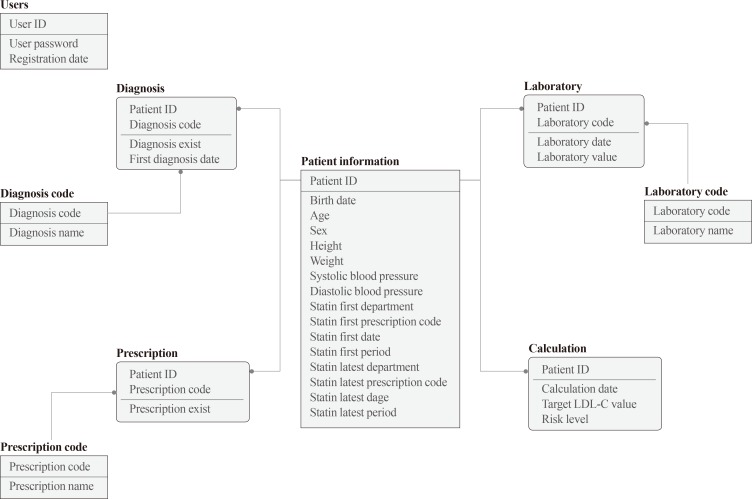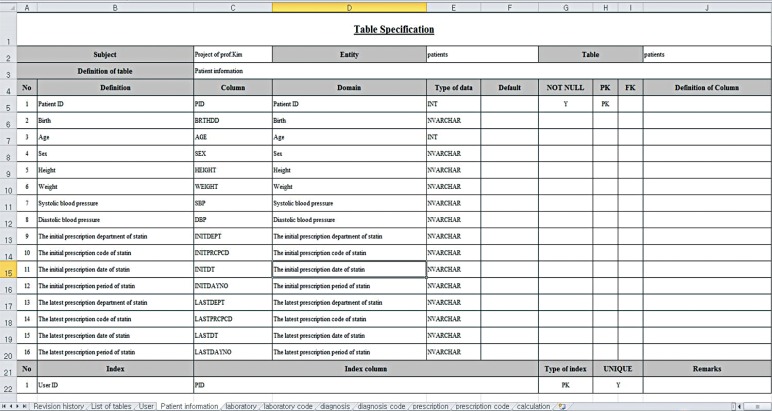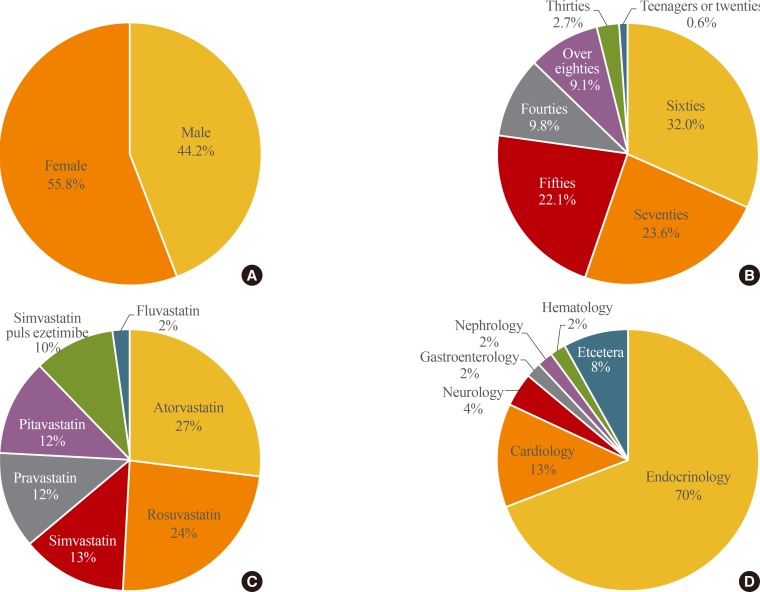Endocrinol Metab.
2017 Mar;32(1):90-98. 10.3803/EnM.2017.32.1.90.
Development of Clinical Data Mart of HMG-CoA Reductase Inhibitor for Varied Clinical Research
- Affiliations
-
- 1Department of Medical Informatics, College of Medicine, The Catholic University of Korea, Seoul, Korea. yoonk@catholic.ac.kr iychoi@catholic.ac.kr
- 2Division of Endocrinology and Metabolism, Department of Internal Medicine, Seoul St. Mary's Hospital, College of Medicine, The Catholic University of Korea, Seoul, Korea.
- 3College of Pharmacy, Sookmyung Women's University, Seoul, Korea.
- KMID: 2413292
- DOI: http://doi.org/10.3803/EnM.2017.32.1.90
Abstract
- BACKGROUND
The increasing use of electronic medical record (EMR) systems for documenting clinical medical data has led to EMR data being increasingly accessed for clinical trials. In this study, a database of patients who were prescribed statins for the first time was developed using EMR data. A clinical data mart (CDM) was developed for cohort study researchers.
METHODS
Seoul St. Mary's Hospital implemented a clinical data warehouse (CDW) of data for ~2.8 million patients, 47 million prescription events, and laboratory results for 150 million cases. We developed a research database from a subset of the data on the basis of a study protocol. Data for patients who were prescribed a statin for the first time (between the period from January 1, 2009 to December 31, 2015), including personal data, laboratory data, diagnoses, and medications, were extracted.
RESULTS
We extracted initial clinical data of statin from a CDW that was established to support clinical studies; the data was refined through a data quality management process. Data for 21,368 patients who were prescribed statins for the first time were extracted. We extracted data every 3 months for a period of 1 year. A total of 17 different statins were extracted. It was found that statins were first prescribed by the endocrinology department in most cases (69%, 14,865/21,368).
CONCLUSION
Study researchers can use our CDM for statins. Our EMR data for statins is useful for investigating the effectiveness of treatments and exploring new information on statins. Using EMR is advantageous for compiling an adequate study cohort in a short period.
Keyword
MeSH Terms
Figure
Cited by 2 articles
-
Proceed with Caution When Using Real World Data and Real World Evidence
Hun-Sung Kim, Ju Han Kim
J Korean Med Sci. 2019;34(4):. doi: 10.3346/jkms.2019.34.e28.Data Pseudonymization in a Range That Does Not Affect Data Quality: Correlation with the Degree of Participation of Clinicians
Soo-Yong Shin, Hun-Sung Kim
J Korean Med Sci. 2021;36(44):e299. doi: 10.3346/jkms.2021.36.e299.
Reference
-
1. Blumenthal D, Tavenner M. The “meaningful use” regulation for electronic health records. N Engl J Med. 2010; 363:501–504. PMID: 20647183.
Article2. Aaronson JW, Murphy-Cullen CL, Chop WM, Frey RD. Electronic medical records: the family practice resident perspective. Fam Med. 2001; 33:128–132. PMID: 11271741.3. Makoul G, Curry RH, Tang PC. The use of electronic medical records: communication patterns in outpatient encounters. J Am Med Inform Assoc. 2001; 8:610–615. PMID: 11687567.
Article4. Chen C, Garrido T, Chock D, Okawa G, Liang L. The Kaiser Permanente Electronic Health Record: transforming and streamlining modalities of care. Health Aff (Millwood). 2009; 28:323–333. PMID: 19275987.
Article5. Christensen T, Grimsmo A. Expectations for the next generation of electronic patient records in primary care: a triangulated study. Inform Prim Care. 2008; 16:21–28. PMID: 18534074.
Article6. Callen JL, Bevis M, McIntosh JH. Patients' perceptions of general practitioners using computers during the patient-doctor consultation. HIM J. 2005; 34:8–12. PMID: 18239223.
Article7. Yoon D, Park MY, Choi NK, Park BJ, Kim JH, Park RW. Detection of adverse drug reaction signals using an electronic health records database: Comparison of the Laboratory Extreme Abnormality Ratio (CLEAR) algorithm. Clin Pharmacol Ther. 2012; 91:467–474. PMID: 22237257.
Article8. Park MY, Yoon D, Lee K, Kang SY, Park I, Lee SH, et al. A novel algorithm for detection of adverse drug reaction signals using a hospital electronic medical record database. Pharmacoepidemiol Drug Saf. 2011; 20:598–607. PMID: 21472818.
Article9. Schneeweiss S. A basic study design for expedited safety signal evaluation based on electronic healthcare data. Pharmacoepidemiol Drug Saf. 2010; 19:858–868. PMID: 20681003.
Article10. Waller PC, Coulson RA, Wood SM. Regulatory pharmacovigilance in the United Kingdom: current principles and practice. Pharmacoepidemiol Drug Saf. 1996; 5:363–375. PMID: 15073807.11. Hauben M, Patadia V, Gerrits C, Walsh L, Reich L. Data mining in pharmacovigilance: the need for a balanced perspective. Drug Saf. 2005; 28:835–842. PMID: 16180934.12. Waller PC, Evans SJ. A model for the future conduct of pharmacovigilance. Pharmacoepidemiol Drug Saf. 2003; 12:17–29. PMID: 12616844.
Article13. Kim HS, Lee H, Park B, Park S, Kim H, Lee SH, et al. Comparative analysis of the efficacy of low- and moderate-intensity statins in Korea. Int J Clin Pharmacol Ther. 2016; 54:864–871. PMID: 27487366.14. National Cholesterol Education Program (NCEP) Expert Panel on Detection, Evaluation, and Treatment of High Blood Cholesterol in Adults (Adult Treatment Panel III). Third report of the National Cholesterol Education Program (NCEP) Expert Panel on Detection, Evaluation, and Treatment of High Blood Cholesterol in Adults (Adult Treatment Panel III) final report. Circulation. 2002; 106:3143–3421. PMID: 12485966.15. Stone NJ, Robinson JG, Lichtenstein AH, Bairey Merz CN, Blum CB, Eckel RH, et al. 2013 ACC/AHA guideline on the treatment of blood cholesterol to reduce atherosclerotic cardiovascular risk in adults: a report of the American College of Cardiology/American Heart Association Task Force on Practice Guidelines. Circulation. 2014; 129:S1–S45. PMID: 24222016.16. Harrison JH Jr. Introduction to the mining of clinical data. Clin Lab Med. 2008; 28:1–7. PMID: 18194715.
Article17. Choi IY, Park S, Park B, Chung BH, Kim CS, Lee HM, et al. Development of prostate cancer research database with the clinical data warehouse technology for direct linkage with electronic medical record system. Prostate Int. 2013; 1:59–64. PMID: 24223403.
Article18. de Mul M, Alons P, van der Velde P, Konings I, Bakker J, Hazelzet J. Development of a clinical data warehouse from an intensive care clinical information system. Comput Methods Programs Biomed. 2012; 105:22–30. PMID: 20728956.
Article19. Lee YH, Bang H, Kim DJ. How to establish clinical prediction models. Endocrinol Metab (Seoul). 2016; 31:38–44. PMID: 26996421.
Article20. Ryan RP, McManus RJ, Mant J, Macleod JA, Hobbs FD. Statins in heart failure: retrospective cohort study using routine primary care data. Ann Med. 2009; 41:490–496. PMID: 19521887.
Article21. Cho Y, Choe E, Lee YH, Seo JW, Choi Y, Yun Y, et al. Risk of diabetes in patients treated with HMG-CoA reductase inhibitors. Metabolism. 2015; 64:482–488. PMID: 25312577.
Article22. Marelli C, Gunnarsson C, Ross S, Haas S, Stroup DF, Cload P, et al. Statins and risk of cancer: a retrospective cohort analysis of 45,857 matched pairs from an electronic medical records database of 11 million adult Americans. J Am Coll Cardiol. 2011; 58:530–537. PMID: 21777752.23. Ohsfeldt RL, Gandhi SK, Fox KM, McKenney JM. Statin cost-effectiveness comparisons using real-world effectiveness data: formulary implications. Value Health. 2008; 11:1061–1069. PMID: 18489494.
Article24. Kim HS, Lee SH, Kim H, Lee SH, Cho JH, Lee H, et al. Statin-related aminotransferase elevation according to baseline aminotransferases level in real practice in Korea. J Clin Pharm Ther. 2016; 41:266–272. PMID: 27015878.
Article25. Jones PH, Nair R, Thakker KM. Prevalence of dyslipidemia and lipid goal attainment in statin-treated subjects from 3 data sources: a retrospective analysis. J Am Heart Assoc. 2012; 1:e001800. PMID: 23316314.
Article26. Kim HS, Kim H, Lee H, Park B, Park S, Lee SH, et al. Analysis and comparison of statin prescription patterns and outcomes according to clinical department. J Clin Pharm Ther. 2016; 41:70–77. PMID: 26791968.
Article27. Hippisley-Cox J, Pringle M, Cater R, Wynn A, Hammersley V, Coupland C, et al. The electronic patient record in primary care: regression or progression? A cross sectional study. BMJ. 2003; 326:1439–1443. PMID: 12829558.
- Full Text Links
- Actions
-
Cited
- CITED
-
- Close
- Share
- Similar articles
-
- Myotonic Potentials in the Myopathy Induced by HMG-CoA Reductase Inhibitor
- A Case of Acquired Ichthyosis Developed During Cholesterol-lowering Treatment
- The Effects of Long Term Use of HMG-CoA Reductase Inhibitor on the Level of Lp (a)
- HMG CoA Reductase Inhibitors Inhibit HCV RNA Replication of HCV Genotype 1b but Not 2a
- Ichthysiform Skin Eruptions Possibly Due to Lovastatin(Mevacor)





